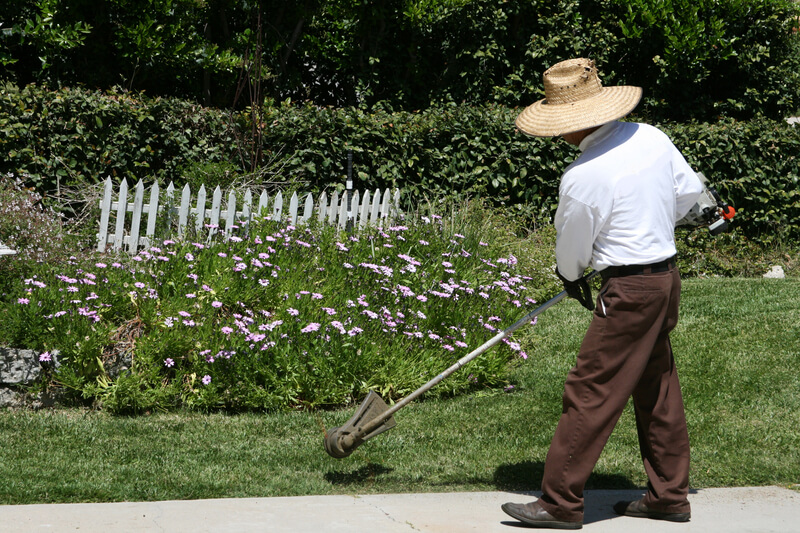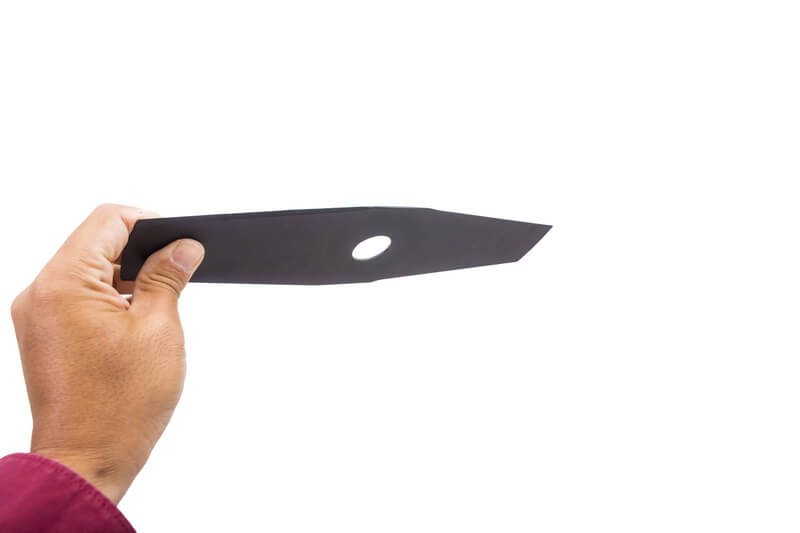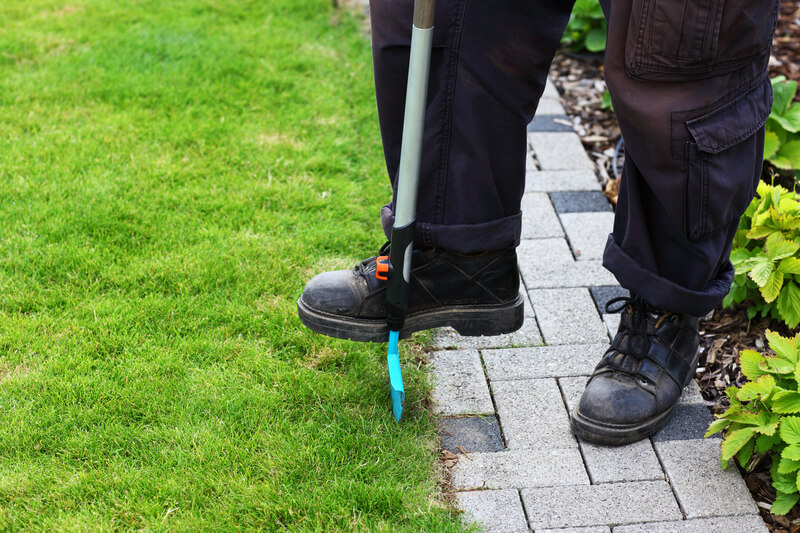Want to boost your lawn and flower bed appeal instantly? Whether you're wondering how to edge a flower bed with an edger or generally how do lawn edgers work, the secret lies in the edges! Lawn edgers are designed to create those neat, distinct borders that define your outdoor space. By separating your grass from flower beds and walkways, you'll enhance aesthetics and prevent unwanted growth. Ready to explore the different types of lawn edgers and find the best way to achieve perfectly defined edges? Let's begin.
Types of Lawn Edgers

Image Source: dreamstime.com
Manual Edgers
Are manual lawn edgers a good choice for keeping your lawn edges sharp?
Manual lawn edgers are straightforward to use and can be effective for maintaining crisp edges, particularly in smaller lawns. These tools typically feature a blade attached to a long handle, allowing you to create a clean cut by applying downward pressure.
- Manual edgers are lightweight, easy to use, and require minimal maintenance.
- They are often a budget-friendly option.
- You have precise control over the depth and angle of the cut, allowing for detailed work.
- They operate without emissions or the need for a power source.
- However, manual edging can be physically demanding, especially for larger lawns or in tough soil.
Electric Edgers
Electric edgers run on electricity, making edging your lawn easy and efficient. These edgers usually have a motor that spins the blade. So, you can make clean and pro-looking edges without breaking a sweat.
- Electric edgers are the way to go - they're light, quiet, and require minimal effort.
- You can adjust the depth settings for better edging.
- The good thing about electric edgers is that they're easy to start and don't require much effort compared to manual ones.
- They're great for cutting through hard soil and big lawns, too.
- The downside of electric edgers is that they can only go as far as the power cord. For bigger areas, you might need an extension cord. These also require a nearby power outlet to operate.
Gas-Powered Edgers
For those heavy-duty edging tasks, gas-powered edgers are the way to go.
- You won't have any trouble cutting through tough soil with the edger.
- You should pick gas-powered edgers for their robustness and superior cutting. They typically feature adjustable blades and depth settings for maximum flexibility.
- Gas edgers are efficient and fast for large areas. They offer greater mobility without the need for a power cord.
- But gas edgers are noisier and bulkier than electric or manual ones.
- Maintenance requirements include fueling and oil changes.
Battery-Powered Edgers
Battery edgers offer a cordless option, providing convenience and versatility. The edgers are powered by rechargeable batteries, eliminating the need for power cords.
- Characteristics of battery-powered edgers include their lightweight design, portability, and ease of maneuvering.
- They commonly offer variable cutting depths and can maintain a steady cutting capability.
- Battery-powered edgers offer the benefits of being less noisy and more environmentally sustainable than gas-powered edgers.
- One potential downside is that the battery life may be restricted. So, you may need to recharge it during extended edging sessions.
- Also, their cutting capacity may not match that of gas-powered edgers.
The Convenience of Push Lawn Mower Edger Attachments for Lawn Edges and Flower Beds
For an incredibly convenient and efficient way to achieve perfectly edged flower beds and lawn edges, consider a push lawn mower edger attachment like the Trimyxs. This innovative tool transforms your existing push lawn mower into a precise edging machine, streamlining your lawn care routine.
- The Trimyxs attachment is a snap to install.
- A key benefit is the reduced fatigue. By attaching to your push mower, Trimyxs allows you to edge your flower beds while walking, minimizing bending and strain.
- This attachment enables you to edge the grass precisely as you mow, saving you time and effort.
- Trimyxs is designed to be compatible with most standard push lawn mower brands, offering a versatile solution for many homeowners.
To further illustrate the convenience of using the Trimyxs attachment for edging, take a look at this short video:
So, whether you prefer the traditional feel of a manual edger, the convenience of electric or battery-powered options, the robust power of a gas model, or the versatile efficiency of a push lawn mower attachment like Trimyxs, there's a lawn edger designed to help you achieve the perfect border for your lawn and flower beds.
Now, let's delve into the details of what makes these edgers cut so cleanly: their blades.
Edging Blades

Image Source: dreamstime.com
The secret to achieving a perfect lawn and beautifully defined flower beds lies in having an edger with efficient blades.
Edger blades are typically constructed from durable materials like high-quality steel to ensure longevity and consistent performance.
Manufacturers often use top-notch steel alloys to enhance the blades' strength and resistance to dulling.
The durability and sharpness of an edger blade can vary depending on the specific materials used in its construction.
For instance, carbon steel blades are renowned for their exceptional sharpness and cutting ability, making them effective for creating clean edges. However, they may require more frequent sharpening and can be susceptible to rust.
Stainless steel blades, on the other hand, offer excellent corrosion resistance and require less maintenance. While they might not be as incredibly sharp as carbon steel initially, they provide a reliable and long-lasting cutting edge
Blade Sharpness and Cutting Efficiency
Maintaining a sharp edger blade is crucial for achieving a smooth and clean cut, which is essential for creating perfect flower bed borders or lawn edging.
Keep your blade sharp with these tips:
- Regularly inspect your edger's blade for any signs of dullness or damage.
- Use a metal file or sharpening stone to carefully hone the blade's edge, removing any rough spots.
- Always follow the manufacturer's recommendations for sharpening your specific edger blade.
- Store your edger properly in a safe place, ideally with a blade cover, to protect the blade and prevent accidents.
The lifespan of your edger's blade depends on several factors, including the frequency of use, the toughness of the grass and soil being cut, and the level of maintenance provided.
Cutting Mechanisms
Lawn edgers employ different cutting mechanisms to create neat and defined edges. The most common methods involve blade rotation or oscillating movement.
In blade rotation systems, the edger blades spin at high speeds, effectively slicing through grass and soil upon contact. Some edgers utilize a single rotating blade, while others feature multiple blades spinning simultaneously to create a clean cut.
Oscillating systems utilize blades that move back and forth in a rapid, side-to-side motion. This type of cutting mechanism is particularly effective for cutting through dense grass and soil without causing excessive tearing or damage to the surrounding areas, making it suitable for delicate flower bed edges.
Regardless of the cutting mechanism, the key to a perfect edge is ensuring that the edger blades are consistently sharp and strong enough to tackle tough grass, roots, and soil.
Power Source

Image Source: vecteezy.com
When choosing a lawn edger, the power source is a crucial factor to consider, as it significantly impacts the tool's performance, ease of use, and suitability for different tasks, including edging around flower beds.
Different types of lawn edgers rely on various power sources to operate effectively.
Let's explore the different power source options available for lawn edgers.
Fuel Types for Gas-Powered Edgers
Gas-powered edgers are designed for tackling the most demanding edging jobs, often found on larger properties or where exceptionally tough soil is encountered around garden beds. These edgers typically operate on various fuel types, each with its advantages and disadvantages.
- Gasoline is the primary fuel source for these edgers, providing ample power and a long runtime. However, it can be messier to handle and produces exhaust fumes.
- Some gas-powered edgers require a specific mixture of gasoline and oil to ensure optimal engine lubrication and performance. While essential, this adds an extra step to the fueling process.
When using a gas-powered edger, always prioritize safety by following these fuel handling guidelines:
- Always adhere to the fuel and mixture ratios recommended by the edger's manufacturer.
- Store gasoline in approved containers and keep them in a well-ventilated area away from heat sources.
- Refuel the edger outdoors or in a well-ventilated area to avoid inhaling fumes.
Battery Options for Cordless Edgers
Cordless edgers, powered by rechargeable batteries, have gained significant popularity due to their convenience and versatility.
- Lithium-ion batteries are the ones you'll find in most cordless edgers. These have got high energy, last longer, and charge quickly. These are light. So, the edger is easier to maneuver.
- Ni-Cd batteries may not be as popular as lithium-ion, but they're still used in some cordless edgers. They are durable and can handle high discharge rates. But they have a lower energy density and may suffer from memory effect.
When considering cordless edgers, pay attention to the battery's voltage, amp-hour rating (Ah), and the expected runtime. Higher voltage often translates to more power, while a higher Ah rating indicates a longer period of use before needing to recharge.
Electric Cords for Corded Edgers
Corded electric edgers rely on a direct connection to a power outlet via an extension cord to operate.
Keep these considerations in mind when using corded edgers:
- The length of your extension cord will determine your reach and mobility. Ensure you have a cord long enough to comfortably edge your entire lawn area.
- While corded edgers offer consistent power without the need for refueling or recharging, their mobility is limited by the cord. Be mindful of the cord's placement to avoid tripping or accidentally cutting it.
Safety is paramount when using corded electric edgers:
- Always inspect the power cord for any damage like fraying or exposed wires before each use.
- Keep the cord away from the edger's cutting path to prevent accidental damage.
- It's highly recommended to plug your corded edger into a Ground Fault Circuit Interrupter (GFCI) outlet or use a GFCI extension cord to protect against electric shock.
Understanding the power source options will help you choose the best lawn edger for your needs, whether you're tackling a small flower bed or a large yard.
Edging Depth and Width

Image Source: dreamstime.com
Ensure your lawn edger features adjustable options for both edging depth and width. So, you can achieve your desired edging size with them.
- You can adjust the edging depth to make sharp borders or dig out pesky weeds and grass.
- You can also adjust the edging width to cut the amount of grass you want. If you want a narrow or wide border, lawn edgers can help you with it.
Here's how to approach setting your desired edging size:
- If you're unsure about the best depth, start with a shallower setting and gradually increase it until you achieve the desired look and functionality.
- To create a wider edge, you may need to make multiple passes along the border, ensuring consistent overlap for an even appearance.
- For maintaining a consistent width, especially over longer distances, consider using stakes and a string line as a visual guide.
Having control over the edging depth and width ensures that your lawn always looks precisely manicured.
What about safety features? Let`s find out.
Safety Features

Image Source: vecteezy.com
When operating any lawn edger, especially powered models, prioritizing safety is crucial. Modern lawn edgers come equipped with various safety features to protect the user.
Protective Guards
Protective guards are an essential safety component on lawn edgers. These physical barriers are designed to shield you and others from the rotating blade and any flying debris that might be ejected during operation.
Various types of protective guards are available, each offering distinct benefits. Some are made from transparent materials, providing visibility of the cutting area while still offering protection. Others may have adjustable settings, allowing you to customize the distance between the blade and the guard according to your specific edging needs.
Automatic Shut-off Switches
An automatic shut-off switch is a critical safety feature on powered lawn edgers. This mechanism is designed to immediately stop the blade from spinning if certain conditions occur, such as excessive vibration, a sudden impact, or a power surge.
These safety switches are crucial for preventing accidents and injuries by quickly deactivating the cutting blade in potentially hazardous situations.
User-Friendly Designs
Many lawn edgers are designed with user-friendliness in mind, incorporating features that minimize risks and enhance operator comfort and control.
Ergonomic handles and grips are key elements of user-friendly design. They provide a comfortable and secure grip, reducing fatigue and enabling better control and stability during operation.
Designs that aim to lessen vibration are also important for safety and comfort. Excessive vibration can lead to discomfort and even injury over prolonged use. Lawn edgers with vibration-reducing features make them easier to handle and less likely to cause accidents due to user fatigue or loss of control.
Always familiarize yourself with the specific safety features of your lawn edger, including how to use the protective guards, automatic shut-off switch, and any other safety mechanisms.
Remember also the importance of wearing appropriate ear protection when using electric or gas-powered lawn edgers, as these can generate significant noise that could potentially damage your hearing.
Ready to consider which edger might be right for you? Here are some factors to keep in mind when purchasing a grass edging tool.
Considerations Before Buying Your Grass Edging Tool

Image Source: vecteezy.com
Don't forget to consider these factors when selecting a lawn edger:
- Assess the size of your yard and the extent of edging you'll be doing. For smaller areas or occasional touch-ups around flower beds, manual or electric models might suffice. For larger properties or extensive flower bed edging, a battery-powered or gas-powered model, or a push lawn mower attachment like Trimyxs, might be more efficient.
- Consider your preference for a power source. Electric models offer ease of use and minimal maintenance, but have the limitation of a cord. Gas-powered models provide power and mobility but require fuel and more maintenance. Battery-powered options offer a good balance of convenience and power. Consider the benefits of using a push lawn mower you already own, equipped with an attachment like Trimyxs, for a seamless experience.
- Keep in mind the importance of adjustable cutting depth, especially if you want to create a more pronounced edge around your flower beds or need to tackle different soil levels.
- Some lawn edgers offer versatility, functioning as trimmers or trenchers as well. If you need a multi-purpose tool, look for models with these capabilities.
- Set a budget before you start your search to help narrow down your options.
With these considerations in mind, you'll be better equipped to choose the right lawn edger for your needs.
How to Edge a Lawn
Edging your lawn right can make it look neat and polished. Here's how to get the best results:

Download our FREE How to Edge a Lawn Guide
Download How to Edge a Lawn Guide
And That's a Wrap!
If you're like most homeowners who enjoy a neat yard, you'll quickly appreciate the value of a lawn edger. From the simplicity of manual models to the powered convenience of options like our Trimyxs attachment, there's a tool to fit every homeowner's needs and effort level.
Now you know how they work and the variety available to achieve those satisfyingly sharp edges that truly enhance your lawn and showcase your flower beds.
What are your favorite secrets or go-to edgers for that perfect homeowner-worthy edge? Join the conversation in the comments!

